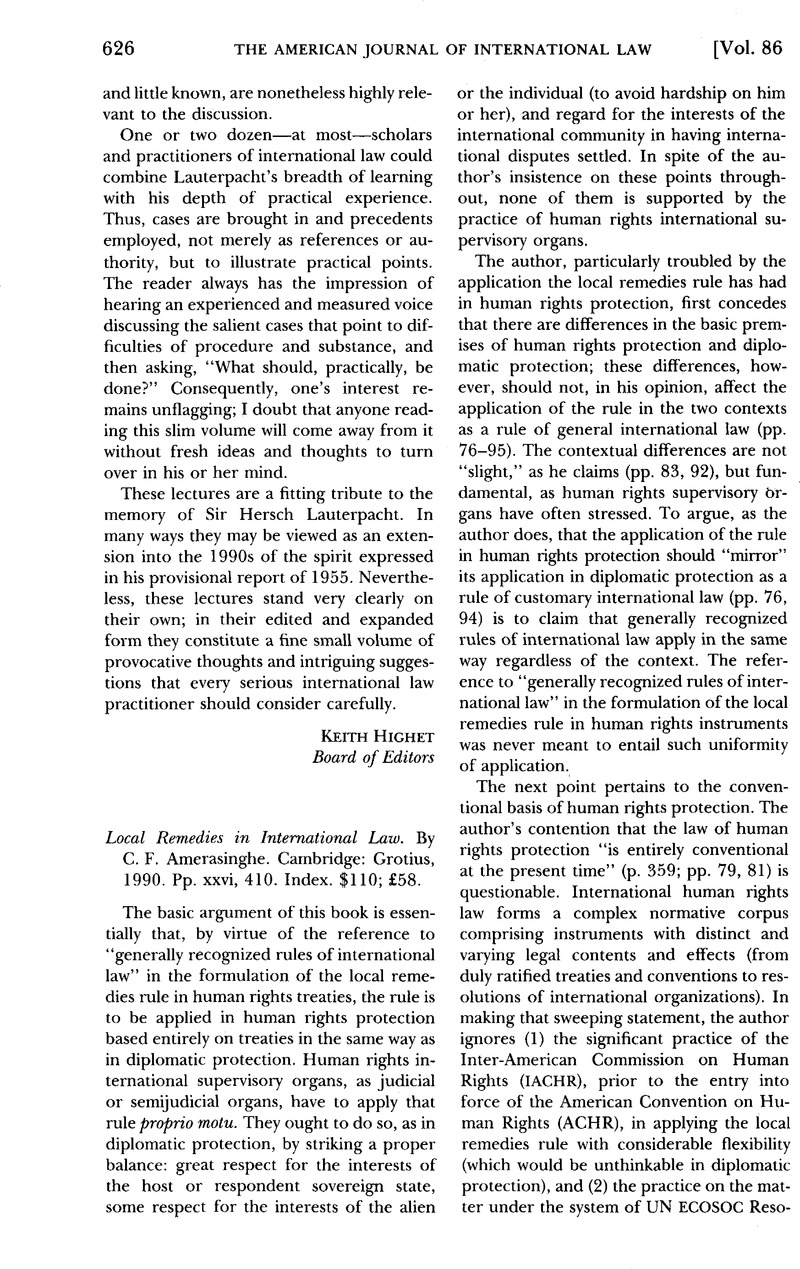No CrossRef data available.
Article contents
Local Remedies in International Law. By C. F. Amerasinghe. Cambridge: Grotius, 1990. Pp. xxvi, 410. Index. $110; £58.
Published online by Cambridge University Press: 27 February 2017
Abstract

- Type
- Book Reviews and Notes
- Information
- Copyright
- Copyright © American Society of International Law 1992
References
1 Deweer v. Belgium, 35 Eur. Ct. H.R. (ser. A) (1980); Foti v. Italy, 56 id. (1982); Dejong, Baljet and van der Brink v. Netherlands, 77 id. (1984).
2 Bozano v. France, 111 id. (1986).
3 App. No. 8007/77, 13 Eur. Comm’n H.R. Dec. & Rep. 152 (1979).
4 Even in diplomatic protection the notion was always surrounded by uncertainties, this being the reason why at times the use of the expression “denial of justice” was deliberately avoided (e.g., at the 1930 Hague Codification Conference, and in the Harvard draft Convention on International Responsibility of States for Injuries to Aliens (Draft No. 12, 1961).
5 OEA/Ser.K/XVI/1.1, doc. 12, at 41–42, 45–51 (1969).
6 Even his taking note of the Honduran cases is incomplete, as he takes into account only the IACtHR’s judgment of 1987 on the preliminary objections, and ignores its judgments of 1988–1989 on the merits.
7 This is the way the local remedies requirement has been applied in the specific context of human rights protection; for example, Communications Nos. 49/1979, 84/1981, 88/1981, 89/ 1981, 147/1983, 156/1983.
8 Judgments, e.g., in Bozano, supra note 2; Bricmont v. Belgium, 158 Eur. Ct. H.R. (ser. A) (1989); DeJong, Baljet and van der Brink, supra note 1; Artico v. Italy, 37 Eur. Ct. H.R. (ser. A) (1980); Corigliano v. Italy, 57 id. (1982); and Ciulla v. Italy, 148 id. (1989); all absent from this book.
9 Granger v. United Kingdom, 174 Eur. Ct. H.R. (ser. A) (1990), likewise absent. Further more, the author fails to note (p. 258) that the dismissal by the Chamber of the ICJ, in the Elettronica Sicula (ELSI) case (1989), of a plea of estoppel with regard to the objection of nonexhaustion is in contrast to the ECtHR’s position on the matter in several recent cases.
10 In some recent cases before the IAComHR, the issue of exceptions to the local remedies rule was given some precision, e.g., inter alia: Case No. 9102 concerning Nicaragua (1986), Case No. 9467 concerning Peru (1987), and La Polvora case concerning Nicaragua (1983), all absent from the present book.
11 IACtHR, Advisory Opinion No. 11, Aug. 10, 1990, paras. 14–40. Such extension of the scope of exceptions is established in the light of the necessity of ensuring the effective protection of human rights. In the same opinion, the IACtHR gave judicial recognition (para. 41) to the distribution or shifting of the burden of proof as to exhaustion between the individual complainants and the respondent state, with a heavier burden upon the latter.
12 Cancado Trindade, Origin and Historical De velopment of the Rule of Exhaustion of Local Remedies in International Law, 12 Revue Belge de Droit International 499 (1976).
13 Cançado Trindade, Denial of Justice and Its Relationship to Exhaustion of Local Remedies in International Law, 53 Phil. L.J. 404 (1978); and idem., The Birth of State Responsibility and the Nature of the Local Remedies Rule, 56 Revue de Droit International de Sciences Diplomatiques et Politiques 157 (1978); respectively.




